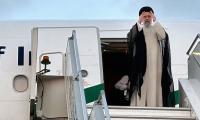LAHORE: The United Kingdom (UK) has been haunted by terrorism since November 5, 1605 when a plot to assassinate King James-I of England was foiled, research reveals, writes Sabir Shah.
Some 36 barrels of gunpowder were discovered under the Palace of Westminster where the country’s nobility and ruling elite had assembled to witness the inauguration of State Parliament.
The plot was to blow up the House of Lords, but an anonymous letter received by the government just a few days before the incident had revealed details of what was going to happen on November 5, 1605.
Men who had hatched this home-grown conspiracy were convicted of high treason and consequently hanged to death. Centuries later, in January 1971, two bombs were exploded by a group called the "Angry Brigade" at the house of a British minister. This incident had prompted the Scotland Yard to establish a bomb squad and the "Angry Brigade" was finally apprehended.
The "Angry Brigade" was a left-wing revolutionary group responsible for a series of bomb attacks in England between 1970 and 1972. Research shows that since the 1970's, terrorists affiliated with various groups like the Official Irish Republican Army, the Palestinian Black September Organisation, Northern Ireland's Ulster Defence Association and the Irish National Liberation Army (INLA) etc have frequently targeted many British cities including London, Birmingham, Manchester, Liverpool, Coventry, Bristol, Glasgow and Southampton etc.
Following are some famous buildings and venues across the United Kingdom, which have been hit by terrorism between 1970 and 2017:
The London Post Office, the Israeli Embassy in London, the Old Bailey (the Central Criminal Court of England and Wales), London's King Cross Station, the M62 Motorway bombing (this incident had killed 12 off-duty British Armed Forces personnel and their family members), the Palace of Westminster art the bank of River Thames (the meeting place of the two British legislative houses--House of Commons and the House of Lords), the Coventry telephone exchange, the Caterham Arms pub in Surrey (it is located just 400 yards from the Army barracks in Caterham), the Iranian Embassy in London, the Army barracks in Chelsea, London's famous Oxford Street, London's Hyde Park and Regent Park (this incident had killed 11 military personnel), the globally-acclaimed luxury departmental store of Harrods (this1983 bombing incident at Harrods had killed six people including three police officers), the Brighton hotel (this 1984 incident had killed five people. This hotel was targeted because Prime Minister Margaret Thatcher and her cabinet were staying here for a conference), Lockerbie (this December 1988 incident in Scotland had seen the bombing of Pan Am Flight 103, killing all 243 passengers and 16 crew.
Large sections of the aircraft crashed onto residential areas of Lockerbie town, killing 11 more people on the ground), the Army barracks at Deal (this 1989 incident at the Royal Marines School of Music building had led to deaths of 11 marines), Wembley (this area is home to Wembley Arena and Wembley Stadium), Lichfield City Railway Station, London Stock Exchange, the rear garden of 10-Downing Street (this 1991 incident was an attempt to assassinate Prime Minister John Major and his War cabinet.
One of the heavy mortar shells exploded in the back garden of number 10, only yards from the cabinet office. Due to the bomb-proof windows, none of the cabinet was hurt, though four other people received minor injuries, including two police officers. The other two shells overshot Downing Street and landed on a green passage nearby), London's Victoria Station, London Bridge Station, the London Baltic Exchange (this exchange is a provider of information on maritime transportation markets.
The April 1992 bombing here had killed three people, besides causing £800 million worth of damage), the Charles Darwin Centre and Shrewsbury Castle (this August 1992 incident had led to the loss of priceless historical artefacts, which were damaged by fire and smoke.
No fatalities or injuries were recorded), London's central business district of Canary Wharf (the planted bomb here had failed to detonate), Bournemouth (In August 1993, the IRA had planted 8 bombs around the British town of Bournemouth of which 5 were detonated in 2 separate attacks), the Balfour House (this prominent building on London's North Finchley High Street and location of the offices of numerous Jewish charities.
The July 1994 bombing had taken place outside the Israeli Embassy had injured five people), London's Charing Cross Road, the 1996 Manchester bombing (already discussed above in opening paragraphs), the Hammersmith Bridge, London, the MI6 Headquarters in London, BBC London, the Hendon post office, the July 7, 2005 Central London bombing (Terrorists had civilians using the public transport system during the morning rush hour. Three bombs were detonated on three separate trains on the London Underground and one on a double-decker bus. 56 people were killed and 700 were injured), the June 2007 Glasgow Airport Attack (Five people were injured in this incident and the only death was of one of the perpetrators), the 2015 Leytonstone Tube Station in East London and the 2017 Westminster attack, etc.
Awami Muslim League chief appeared in the court with his lawyers Sardar Raziq and Sardar Shehbaz
Board meeting also allowed increase in business center and commercial area of hotel plots from 5 to 10 percent along...
Foreign exchange reserves currently stand at $8 billion, while Pakistan would also receive $1.1 billion IMF tranche:...
CM directed that the enforcement authorities be made functional in six months, and legislation in this regard be...
Pakistani soldiers and policemen stand guard outside the Haripur central jail. — AFP/FileWASHINGTON: The Pakistani...
Establishment Division has also issued an NoC to fill 465 civilian posts in the Ministry of Defence and 11 posts in...







